Diwali Celebration in India | Customs & Regional Variations
Diwali, known as the Festival of Lights, is celebrated with enthusiasm and unity across India, though each region adds its own distinctive flavor. This guide takes you through how different parts of the country honor tradition, from lighting lamps to bursting crackers, creating rangoli, and performing special pujas. Let's unpack the customs, significance and the regional variations behind India's grandest festival. Also learn about the exclusive traditions that are followed by various states on the occasion of Diwali.
Diwali Celebration
India, a country renowned for its diversity and unity, is a land rich in various cultures, traditions, and festivals. While each festival may have its own unique customs, the spirit of celebration remains uniform across the country. Diwali is a prime example of this phenomenon. It is a pan-Indian festival celebrated with great enthusiasm, though there are minor distinctions in the mode of celebration from region to region, reflecting India's diverse cultural landscape.
Diwali is a five-day festival that marks the beginning of the Hindu New Year. It is a celebration of the triumph of good over evil and light over darkness. The festival also signifies the onset of winter. The most widely recognized significance of Diwali is the honor it bestows upon Lord Rama and his wife, Sita. The festival commemorates their return to their kingdom of Ayodhya after a fourteen-year exile. This homecoming followed a victorious battle in which Lord Rama, with the help of the monkey god Hanuman, defeated the demon king Ravana and rescued Sita from his clutches. The victory itself is celebrated on the festival of Dussehra, which precedes Diwali.
The celebration is marked with equal fervor and zeal across all of India. Almost every Indian participates in the festivities by lighting lamps and bursting fireworks, embodying the spirit of hope and new beginnings.
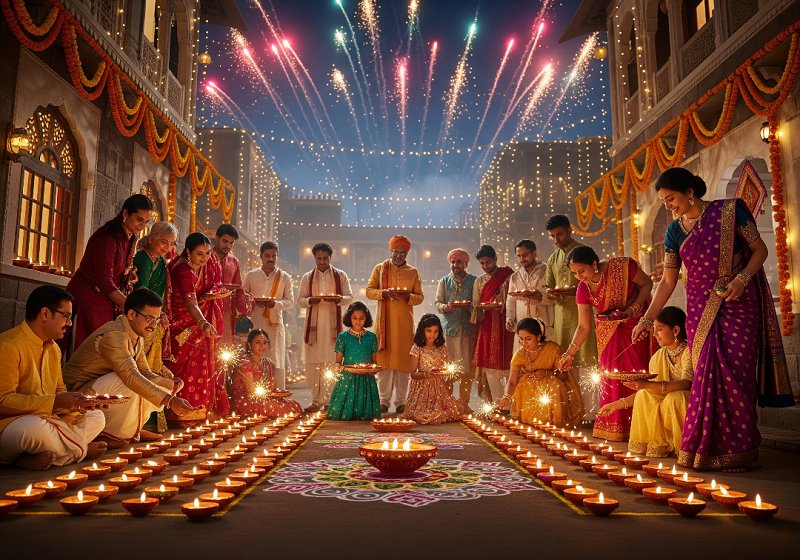
Diwali Across India: Regional Celebrations
Northern India
As Diwali is supposedly celebrated on the occasion when Lord Rama along with wife Sita and brother Lakshman returned to his capital Ayodhya, after defeating and killing the evil King Ravana and spending fourteen years in exile. It was a new moon day of the Kartik season. His homecoming was thus greatly celebrated with lights, fireworks, bursting of crackers and merriment. This tradition of Diwali celebration continued to be observed to this day in the northern states of Uttar Pradesh, Punjab, Haryana, Bihar and the surrounding areas where huge effigies of Ravana are burned implying Lord Rama's annihilating of the demon king. Thus the Diwali nights in these areas, are nights of fireworks and crackers. They are burnt all night long to celebrate the occasion.
The people of North India make it a point that along with worshiping Goddess Kali on the day of Diwali, they equally worship the idols of Goddess Lakshmi as well Lord Ganesha, for Goddess Lakshmi symbolises wealth and prosperity and whereas the elephant-headed god is the epitome of auspiciousness and wisdom. Thus they are worshipped with most austerity in most of the Hindu homes on this day. In fact most of the temples as well dedicated to the worship of Lord Rama or Krishna celebrate Diwali with great piety and eagerness.
Eastern India
The eastern India is no less in their enthusiasm. It is almost a common site in the state of Orissa where everyone decorates their houses with the light of oil lamps, candles and lanterns that are generally placed in rows. In order to heighten the celebration further, crackers are burst, sparklers are lighted and gifts and sweet are distributed amongst the people of the state. Thus the ways of celebration on the Eastern part of India is almost alike like anywhere in India except for one ritual that calls upon the spirits of the family's forefathers.
One of the primitive customs that is duly followed in this festival is the burning of jute stems. This custom is solely followed so as to light up the dark paths that help the spirits of the ancestors to trace back their path to heaven. Most of the houses are brightly lit and the doors and windows are kept open to welcome Goddess Lakshmi, who is supposed to visit every home during this time and ignores all places that are kept dark and abandoned.
In West Bengal however Lakshmi puja is celebrated earlier than the Diwali celebrations and the deity celebrated on this occasion is the fierce avatar of Goddess Kali. "Kali Puja" or the worship of Goddess Kali is what makes the celebration in this part of India a unique one. In Kolkata, the capital of the state, as well as in all the other parts of West Bengal, the nights of "Kali Puja" are marked by high festivities that consists of activities similar to other regions like bursting crackers, holding dazzling fireworks display, lighting rows of candles and diyas around individual homes, painting colorful patterns at the doorstep, dressing up in new apparels and paying a visit to friends and relatives. Across the state, makeshift structures called pandals, made of articles as bamboos and cloth, are erected that house idols of Goddess Kali for the two days of celebration. The actual worship of the deity is, however, done only for one night during this festival. It is also believed that it is the night of the 'Pitripurush' (ancestors) and lamps are lit on long poles to guide their souls on this night. But the practice is more common in rural areas of Bengal than in cities like Kolkata.
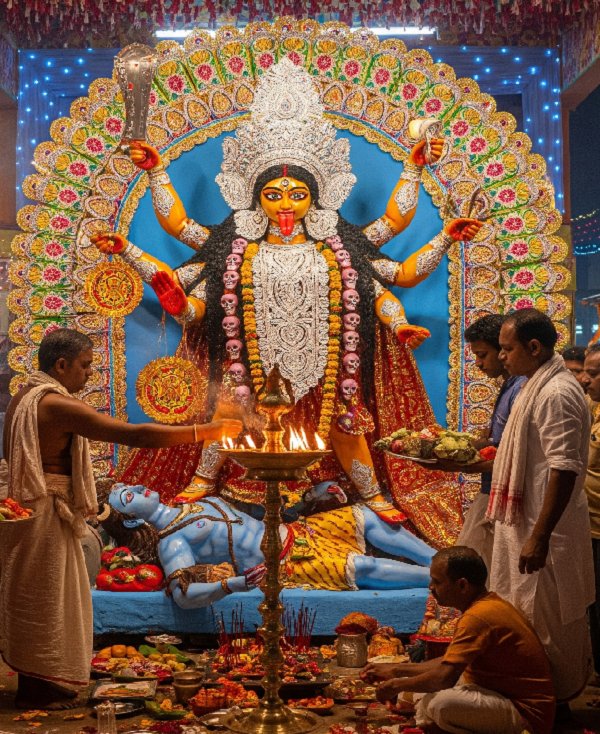
Western India
The western states of India celebrate Diwali for four days, the preparations for which begin at least 15 days prior to the final celebration. People engage themselves in a month-long shopping and making preparations for the occasion. Markets all over make arrangements to cater the month requirements of Diwali shoppers and thus in way boost their business transactions as well.
The Gujarati community starts celebrations in different ways. Just the nights preceding the festival, they start their celebration by creating various designs with natural powder colors (called "Rangoli") in their verandas. These designs are depiction of images associated to the festival like the deities, sun and flowers. Images of small footprints are also drawn over individual doorsteps which are supposed to be a way of inviting Goddess Lakshmi to the house.
The four day long festival is individuated with individual rituals and customs for the first day of the festival which is Narakchaturdashi when fruits are smashed and crackers are burst thus to symbolize the killing of the evil demon Narakasur. The second and most important day of Diwali is dedicated to Lakshmi Puja, when Hindu homes all over the western region of India worship the idols of Lord Ganesh (deity of auspiciousness and wisdom) and Goddess Lakshmi (deity of wealth and prosperity) or symbols of them like currency notes and gold. The third day or the Padawa is considered to be one of the most auspicious days of the year in states like Maharashtra for it is held to be auspicious for any mew beginning. Thus the third day is entirely dedicated to shopping, lighting diyas (earthen lamps) and as well performing the tilak ceremony.
The people of Gujarat however consider this day as a New Year day thus make this day as an opportunity to visit each other and to wish each other a new beginning. Bhau Beej is the last day of the festival which signifies sibling bonding. The celebrations during this day are quite akin to that of Raksha Bandhan, another great Indian festival that is dedicated to strengthen the bond of brother-sister relationship. Unlike Raksha Bandhan however, which is a day dedicated to brothers, Bhau Beej is dedicated to sisters.
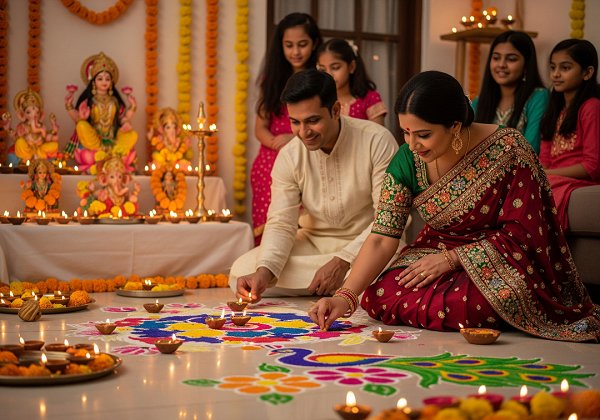
Southern India
Diwali in the southern part takes a different turn for various exclusive Diwali customs are observed in Tamil Nadu. The people of Tamil Nadu observe this once-in-a-lifetime event, Thalai Deepavali, which is observed by newlyweds who are entitled to celebrate their first diwali after marriage in the bride's parental home. According to the traditions associated, the newly married couple, after taking blessings from the elders are supposed to burst the first crackers of the day and thereafter pay a visit to the temple, get gifts of clothes and jewellery, savor on the sweets that are reserved for them and receive blessings of elders for a happy married life. In this joyful occasion the groom's parents and relatives also come down to join in the celebrations.
However the people of Maharashtra celebrate Diwali for four days. The first day which is Vasubaras, is celebrated by performing an Aarti of the cow and its calf. This Aarti is observed for it enhances the love between a mother and her baby. The next day is known as the Dhanatrayodashi or Dhanteras which is a special day dedicated to tradesmen and business people for this day is considered auspicious for opening new account books after a worshiping Lord Ganesh and Goddess Lakshmi. The third day or Narakchaturdashi is when people get up before sunrise and take a bath by rubbing scented oil on their body. Once done with the bathing custom, the entire family visits a temple and offers their prayers to the God, following which everyone is supposed to feasts on Faral, a special Diwali preparation consisting of delicious sweets such as "karanji" and "ladoo" as well as some spicy eatables like "chakli" and "sev". And the fourth day is the Lakshmi pujan day, a new moon day, on which the dark night is illuminated by lamps and fireworks. In every household, an idol of Goddess Lakshmi and items of wealth like currency and jewellery are worshipped. Friends, neighbours and relatives are invited over and celebrations are in full swing.
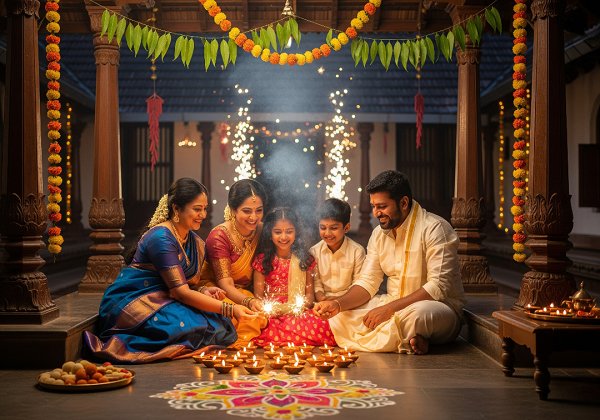
Rural India
In rural India, Diwali is celebrated with a unique purpose as a harvest festival. For farmers, it is a time of immense joy and gratitude, as they give thanks to God for a successful crop. The celebrations are vibrant and energetic, reflecting the prosperity they have been granted.
The festivities are marked by a number of special customs that honor the deities. A primary tradition is the creation of colorful Rangoli or Kolam designs. These intricate patterns, often depicting the footsteps of Goddess Lakshmi, are drawn on doorsteps. It is a widespread belief that these designs welcome wealth, fortune, and prosperity into the home.
Inside most Hindu homes, idols of Goddess Lakshmi and Lord Ganesha are worshipped during the day. However, the true jubilations begin at dusk. The night is transformed by a beautiful spectacle of light as tiny earthen lamps (diyas) and candles are arranged in rows around homes. People wear new clothes, light firecrackers, and burst sparklers. The celebrations extend beyond the home, as families visit friends and relatives to exchange gifts and wish them a happy Diwali.
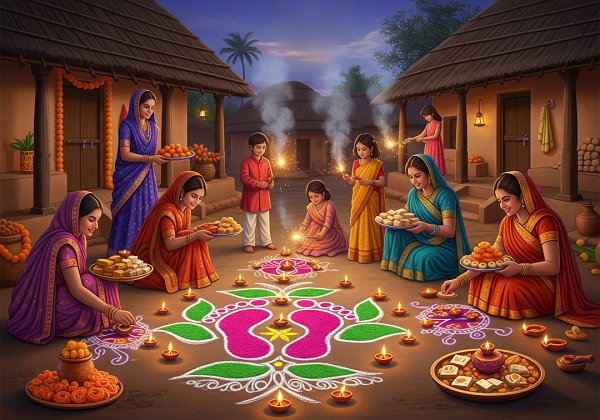
Thus all these illuminations and fireworks, joy and festivity, symbolizes the triumph of righteous over those of wickedness, or rather - of good over evil.
 Change Language:
Change Language:
Try out the other sections


 Christmas
Christmas Thanksgiving
Thanksgiving Craft Ideas for Kids
Craft Ideas for Kids Benefits of Yoga for Kids
Benefits of Yoga for Kids School Projects & Homework Help
School Projects & Homework Help